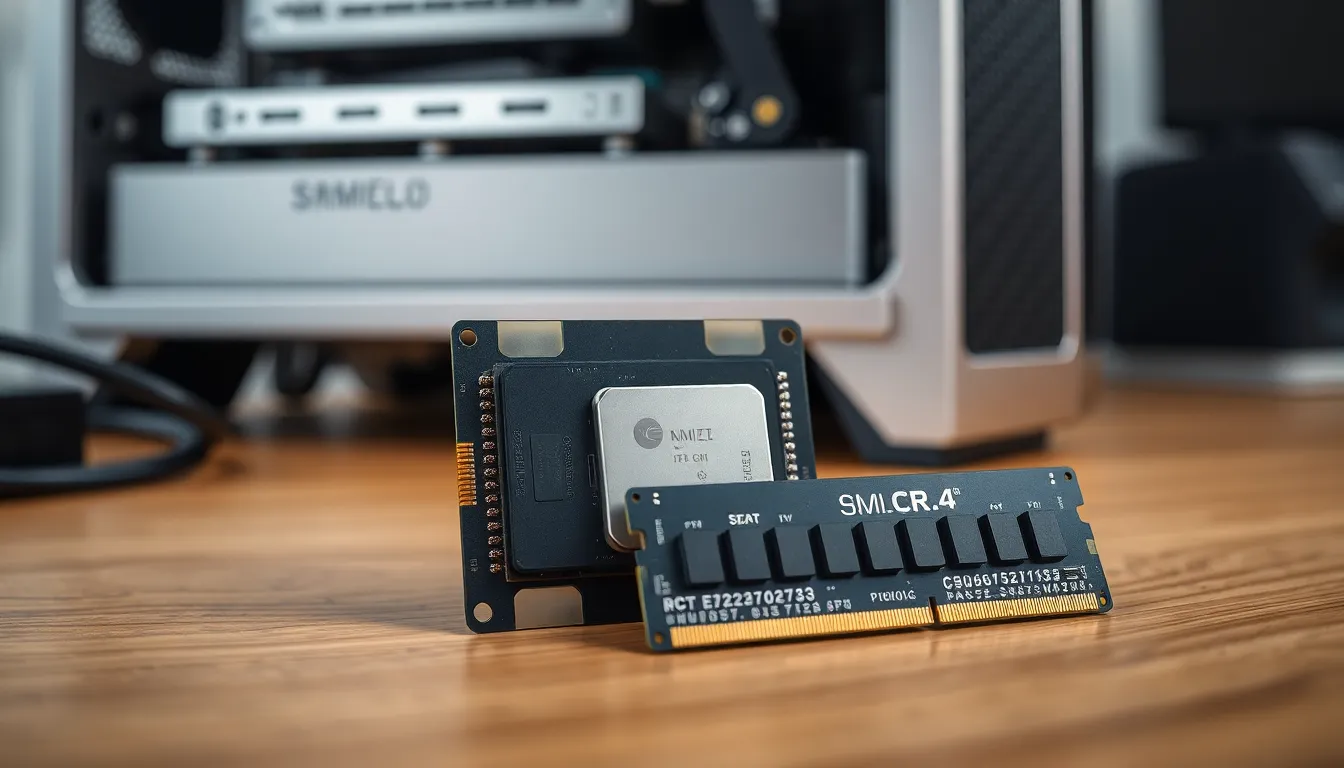Table of Contents
ToggleEver wondered what makes your computer tick? The hardware layer in computer architecture is like the secret sauce in your favorite burger—essential yet often overlooked. It’s the backbone that supports everything from your favorite video games to that endless scroll through cat memes. Without it, your shiny device would be nothing more than a glorified paperweight.
Overview of Computer Architecture
Computer architecture consists of multiple layers, where each component plays a crucial role in overall functionality. The hardware layer forms the foundation, including essential components such as the central processing unit (CPU), memory, storage devices, and input/output systems. These hardware elements work together to execute instructions and manage tasks.
CPUs act as the brain of the computer, processing instructions and performing calculations. Memory, like random access memory (RAM), provides temporary storage for active processes, ensuring quick access to data. In contrast, persistent storage devices, such as hard disk drives (HDDs) and solid-state drives (SSDs), retain information long-term.
Input and output systems enable interaction with users and other devices. Keyboards, mice, and monitors serve as primary input and output devices, allowing for user commands and displaying results. Networking components, including network interface cards (NICs) and modems, facilitate communication with other devices and the internet.
Important hardware aspects also include buses and data pathways. Buses transfer data between components, ensuring effective communication and resource sharing. The system architecture determines the performance and efficiency of data exchanges throughout the hardware layer.
Additionally, specialized hardware, such as graphics processing units (GPUs), focuses on rendering images and videos. These components enhance multimedia experiences, making gaming and design applications more immersive. System buses also connect GPUs to CPUs, allowing seamless collaboration.
Understanding these components and their relationships helps clarify how hardware forms the backbone of computer systems, enabling various applications and functionalities that users experience every day.
Definition of Hardware Layer

The hardware layer in computer architecture forms the essential foundation for all operations within a computer system. It comprises various critical components that work collaboratively to execute tasks and manage processes efficiently.
Components of the Hardware Layer
Key components of the hardware layer include the central processing unit (CPU), memory modules, storage devices, and input/output systems. The CPU functions as the brain, executing instructions and processing data. Memory, including random access memory (RAM), provides temporary storage for actively running applications. Long-term information is retained by storage devices such as hard disk drives (HDDs) and solid-state drives (SSDs). User interaction is facilitated through input/output systems like keyboards, mice, and monitors. Networking components enable communication between devices and the internet, completing the essential hardware configuration.
Importance of the Hardware Layer
Understanding the hardware layer’s significance is crucial for appreciating overall computer functionality. This layer affects performance across applications, from gaming to data processing. It directly influences speed and responsiveness, as the efficiency of hardware components determines how quickly tasks complete. Reliable communication between components relies on buses and data pathways, enhancing collaboration for optimal performance. Specialized hardware, such as graphics processing units (GPUs), improves multimedia experiences, proving that a robust hardware layer is vital for modern computing tasks.
Types of Hardware Components
The hardware layer includes several critical components vital for a computer’s functionality. Each type serves a unique purpose in processing and managing tasks.
Central Processing Unit (CPU)
The CPU serves as the computer’s brain, executing instructions and processing data. This component consists of cores that handle various tasks simultaneously, enhancing performance. Modern CPUs often incorporate integrated graphics, which improve multimedia capabilities without requiring a separate graphics card. System performance heavily relies on clock speed and cache size, influencing how quickly data is processed. In multi-core situations, tasks distribute across cores, boosting efficiency for complex applications.
Memory Units
Memory units include both volatile and non-volatile types, crucial for data processing. RAM acts as temporary storage, enabling quick access to active processes. This dynamic memory allows applications to run smoothly, as data is easily retrieved. Cache memory, located within the CPU, further accelerates data fetching by storing frequently accessed information. In contrast, Read-Only Memory (ROM) retains essential software instructions even when powered off. Overall, adequate memory allocation enhances overall system performance.
Input and Output Devices
Input and output devices facilitate user interaction with the computer system. Common input devices like keyboards and mice allow users to issue commands efficiently. Likewise, output devices such as monitors and printers provide visual or printed results for user tasks. Specialized devices, including touchscreens and scanners, offer alternative interaction methods. These components work together to create an intuitive user experience while effectively transmitting data to and from the hardware layer.
Storage Devices
Storage devices are critical for retaining data over time, encompassing both short-term and long-term storage solutions. Hard Disk Drives (HDDs) provide large storage capacity at a lower cost, making them a popular choice for many users. Solid State Drives (SSDs), on the other hand, offer faster data retrieval speeds and improved durability, making them ideal for performance-centric tasks. External storage options, like USB flash drives, enable easy data transfer between systems. Choosing appropriate storage solutions influences data management and access times, directly impacting overall productivity.
Role of the Hardware Layer in System Performance
The hardware layer significantly impacts system performance. Essential components, such as the CPU, directly influence processing speed and efficiency. Multi-core processors handle multiple tasks simultaneously, enhancing overall system responsiveness.
Memory units, including RAM, play a crucial role in data access speed. Faster RAM allows for quicker loading times and smoother multitasking. Non-volatile memory types, like SSDs, improve data retrieval rates, ensuring quicker boot times and application launches.
Storage devices serve as crucial components for data retention and management. HDDs offer substantial storage capacity, but SSDs provide superior speed and durability. The choice between these storage types affects not just data access times but overall system performance.
Input and output devices also contribute to user experience. High-quality input systems, such as gaming keyboards and professional mice, ensure accuracy and responsiveness. Meanwhile, displays with higher refresh rates deliver smoother visuals, especially in multimedia applications.
Effective communication among hardware components relies on buses and data pathways. These channels allow data transfer without bottlenecks, enhancing performance during intensive tasks. As a result, efficient data flow leads to improved application performance and user satisfaction.
Finally, specialized hardware like GPUs drastically elevates multimedia experiences. They handle complex graphical computations, reducing the load on CPUs and speeding up visual rendering. With advancements in GPU technology, users can enjoy high-definition graphics in gaming and professional applications.
By prioritizing these components, the hardware layer ensures the computer operates efficiently. Understanding these relationships helps clarify how each element contributes to overall system performance.
Trends in Hardware Architecture
Emerging trends in hardware architecture focus on enhancing performance, efficiency, and user experience. Innovations in multi-core processors significantly improve multitasking capabilities, allowing systems to handle multiple applications seamlessly. Increased reliance on solid-state drives (SSDs) exemplifies a shift toward faster data retrieval, reducing loading times for applications and operating systems.
Virtual reality (VR) and augmented reality (AR) technologies demand advanced graphics processing units (GPUs). These components now deliver extraordinary rendering capabilities, essential for immersive experiences. Integration of artificial intelligence (AI) in hardware design influences the architecture, promoting adaptability and smart processing features in devices.
Energy efficiency plays an important role in hardware development. Manufacturers are prioritizing lower power consumption without compromising performance, appealing to environmentally conscious consumers. Additionally, the shift towards edge computing necessitates hardware that supports localized processing, enhancing response times and reducing latency for applications.
Inclusion of advanced cooling technologies helps manage heat generated by high-performance systems. Liquid cooling solutions are increasingly common, improving reliability and extending hardware lifespan. Security has also become a focal point, with hardware-based security features shaping the design of new processors, aiming to protect sensitive data from threats.
Mobile computing continues to alter hardware architecture trends. Lightweight designs and robust performance are essential as more users rely on laptops and devices for everyday tasks. With the continuous evolution of cloud-based services, hardware capacities need constant upgrades to accommodate extensive data processing and storage requirements.
Adapting to these trends ensures that hardware architecture remains relevant and powerful, supporting the ever-changing landscape of computing needs.
The hardware layer in computer architecture serves as the backbone of all computing activities. Its various components work in harmony to execute tasks efficiently and effectively. As technology evolves, advancements in hardware design continue to enhance performance and user experience.
From multi-core CPUs to the rise of SSDs and specialized GPUs, each innovation reflects the industry’s commitment to meeting modern demands. Energy efficiency and security are becoming increasingly important, shaping future developments in hardware architecture. Understanding the hardware layer’s significance not only clarifies its role in everyday computing but also highlights the ongoing evolution that drives the technology forward.










